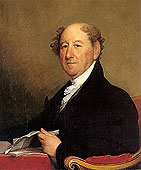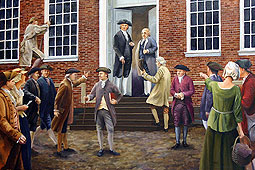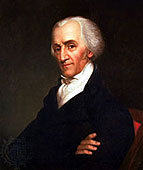For Teachers: Lessons
Lesson 7: Making a Nation: The Philadelphia Convention
Learning Objectives
After completing this lesson, students will be able to:
- Explain the purpose of the Philadelphia Constitutional Convention and how it came about
- Describe the role that Shays’ Rebellion played in the Convention
- Compare and contrast the concerns and key arguments of the Federalists and the Anti-Federalists
- Describe and evaluate the views of the key players at the Convention
- Describe the make-up of the Massachusetts delegation and explain their positions on key issues at the Convention
- Explain why the proceedings were kept secret
- Identify and describe the compromises reached during the Convention
- Analyze primary source documents
Skills
- Interpreting visual information
- Observing and describing
- Thinking critically
- Expressing opinions
- Analyzing visually
- Understanding historical perspective
- Gathering and using information
- Interpreting information
Introduction
In this lesson, students learn that while the Philadelphia Convention was called for the ostensible purpose of amending the Articles of Confederation, several delegates arrived with a far more ambitious agenda: to replace the Articles entirely with a new and stronger federal government. Concern with the unrest in Massachusetts and the lack of resources with which the Confederation Congress could respond to the crisis weighed on the delegates, and the Convention became an intense three-month struggle between those favoring a stronger central government—the Federalists, and those favoring stronger state government—the Anti-Federalists. The scene is the front of the Pennsylvania State House in Philadelphia as the convention delegates—including Washington, Franklin, and the Massachusetts delegates—enter the building for another day of deliberations. As Philadelphians look on, their knowledge of the proceedings, like other Americans, is limited to newspaper reports that the delegates are charged with revising the existing Articles of Confederation.
 |
 |
 |
| Rufus King. Courtesy National Portrait Gallery, Smithsonian Institute, Washington, DC | Making a Nation, © 2008 Bryant White | Elbridge Gerry. Courtesy Independence National Historical Park, Philadelphia, PA |
Guiding Concepts
While the insurrection in Massachusetts was just about over by the spring of 1787, it was very much present at the Constitutional Convention, and played a major role in strengthening the hand of those who favored a stronger central government. States selected delegates to the Convention over the winter while news from Massachusetts made it appear to many as though Massachusetts was spiraling into a bloody civil war. Delegates arrived in Philadelphia while convicted Regulators languished in jails, some under sentence of death for high treason. Confederation Secretary of State Henry Knox even observed that while the immediate danger had passed, it behooved the Massachusetts government to hang several leaders to discourage others from taking arms against the state. The Convention met from May 25 to September 17, 1787. Almost immediately, the delegates chose to scrap the Articles of Confederation, under which the Congress had not been able to gather a quorum or raise revenues. For over three months of intense discussion and debate, those who favored a stronger central government pressed their issue, resulting in a new Constitution with the power to raise revenue and “insure domestic tranquility.”
Preparing to Teach
- Familiarize yourself with the Articles of Confederation, ratified in March of 1781, especially articles 8, 9 and 12. These can be found in the Artifacts & Documents section of the website.
- Familiarize yourself with the key provisions of the US Constitution proposed at the Philadelphia Constitutional Convention of 1787.
- Familiarize yourself with the Making a Nation historic scene, linked to from the Historic Scene menu. Read the three tabs, then roll your cursor over the highlighted hot spots in the illustration. Follow the links in the rollovers. Below the illustration and the tab content, read the four OBSERVER comments, the four essays in the THEMES section, and follow the links in the RELATED TO THIS SCENE section.
- Familiarize yourself with the Library of Congress’ Using Primary Resources.
- Although not explicitly referred to in the lesson, you can incorporate selections from the Timeline and Music section into the lesson.
Teaching the Lesson
- Class Assignment: Prior to the one or two class periods spent on this lesson, make the following website preparation assignment:
- From the Historic Scene menu, go to the Making a Nation historic scene, and read the Overview tab, the Federalist tab, and the Anti-Federalist tab. Roll your cursor over the rollovers within the illustration and read the text. Note that only the highlighted rollovers for each tab display pop-ups.
- Read the observer comments, the four essays in the themes section, and follow the links in the related to this scene section, studying the material displayed.
- Go to the Artifacts & Documents section of the website. Search for the Articles of Confederation. Pay particular attention to Articles 8, 9 and 12.
- Go to the Artifacts & Documents section of the website. Search for the US Constitution and read it.
- Assign each of the following characters to students (or a small group of students) so the student(s) can assume that historic persona in class: Massachusetts delegation: Elbridge Gerry, Caleb Strong, Rufus King; George Washington; Benjamin Franklin; John Madison; Henry Knox; and Alexander Hamilton. Students can learn about thier characters by looking them up in the People Menu and by searching for their correspondence in the Artifacts & Documents section.
- Assign the following observers to students (or a small group of students) so the student(s) can assume that historic persona in class: Thomas Jefferson, Richard Price, Anonymous Correspondent for the Hampshire Gazette, Samuel Adams. Jefferson and Adams have character narratives in the People menu.
- Class Activity: Debate: Federalists vs. Anti-Federalists Debate the Proposed Constitution: Assemble the debaters at the front of the room and hold a debate about the new Constitution. Make sure the Federalist side is familiar with the Federalist tab, and the Anti-Federalist side is familiar with the Anti-Federalist tab. Use the discussion questions below. Additional materials can be read to enhance students’ familiarity with the arguments on both sides of the issues. Search for correspondence in the Artifacts & Documents section using the names Justin Hitchcock and Park Holland for the Federalist viewpoint. A good source for Elbridge Gerry’s Anti-Federalist view is a letter he sent to the Massachusetts’ General Court following the Philadelphia Convention. You can also use the Looking Glass cartoon as in indication of one historic view of the Federalist vs. Anti-Federalist Debate in 1787.
- Class Activity: Primary Resource Study: Project the US Constitution found in the Artifacts & Documents section of the website. Select students to read key sections of the document. Project and read comments made about this document, found in the related to this scene links. Use the zoom and the transcript to examine closely the handwriting and any words you have difficulty understanding. Discuss the key sections of the document.
- Class Discussion Questions:
- What sorts of problems did the delegates hope to address at the Constitutional Convention? (need for an expansion of federal powers; need for protections for states and their citizens)
- What sort of role or influence do you think the conflict in Massachusetts played in the debates and in the final document?
- Benjamin Lincoln and Henry Knox personally kept George Washington abreast of the Regulators’ activities and the unrest in Massachusetts. Do you think they painted an accurate picture? (painted it in the darkest of terms, calculated to confirm Washington’s worst fears about the potential collapse of the state republics, they knew that their cause would be strengthened by Washington’s participation)
- What were the circumstances surrounding George Washington’s participation in the Convention? (Shays’ Rebellion helped persuade him to come out of retirement and chair the proceedings.)
- What were the sentiments of the four Massachusetts delegates about the key issues at the Convention? (Only Gerry did not favor a strong central government; he believed a strong central government would deprive the states of their sovereignty and wanted the proposed Constitution to include a bill of rights.)
- What was the “unique” case that three of the Massachusetts delegates made for a stronger central government? (US was powerless to offer assistance during Shays’ Rebellion)
- What were the concerns of James Madison? (lack of credit worthiness of the federal government and the fiscal policies of the states caving to demands for debtor relief) Do you see any parallels with today?
- What were the key arguments of the Federalists? (see tabbed content)
- What were the key arguments of the Anti-Federalists? (see tabbed content)
- What was the significance of the failure of Rhode Island to attend the Convention? (Rhode Island’s non-attendance was the exception that proved the rule—state power must be curbed)
- What were the compromises reached during the Convention? (Great Compromise, Three-Fifths Compromise, Slavery Compromise)
- If the founding fathers were alive today, how do you think they would feel about our current government and its interpretation of the Constitution? Think of recent Supreme Court rulings and actions taken by the administration.
Additional Resources
Books
- Gross, Robert, ed. In Debt to Shays: The Bicentennial of an Agrarian Rebellion, volume 65. Boston, MA: The Colonial Society of Massachusetts, 1993.
- Richards, Leonard. Shays’s Rebellion: The American Revolution’s Final Battle. Philadelphia: University of Pennsylvania Press, 2002.
- Starkey, Marion. A Little Rebellion. New York: Knopf, 1955.
- Satzmary, David. Shays’ Rebellion: The Making of an Agrarian Insurrection. Amherst, MA: University of Massachusetts Press, 1980.
Websites
- Gilder Lehrman Institute of American History: Modules on the Constitution for Teachers
- PBS: Lesson Plan on The Constitution and the Idea of Compromise
- Library of Congress: Elbridge Gerry’s Reasons for Not Signing the Federal Constitution
- Library of Congress: Using Primary Resources
- Library of Congress: Digital Resources Related to the American Revolution
- Library of Congress: American Memory
- Shay’s Rebellion Song
- Best of History Websites: American Revolution and Independence
- PBS: Liberty: The American Revolution
- Edsitement: History and Social Studies
- James Madison Center: US History Curricula
- History Institute, University of Massachusetts: Shays’ Rebellion and Related Resources
Movies
- The History Channel Series: 10 Days That Changed America: Shays’ Rebellion: America’s First Civil War; 60 minutes
- Calliope: A little Rebellion Now and Then: Prologue to the Constitution; 30 minutes